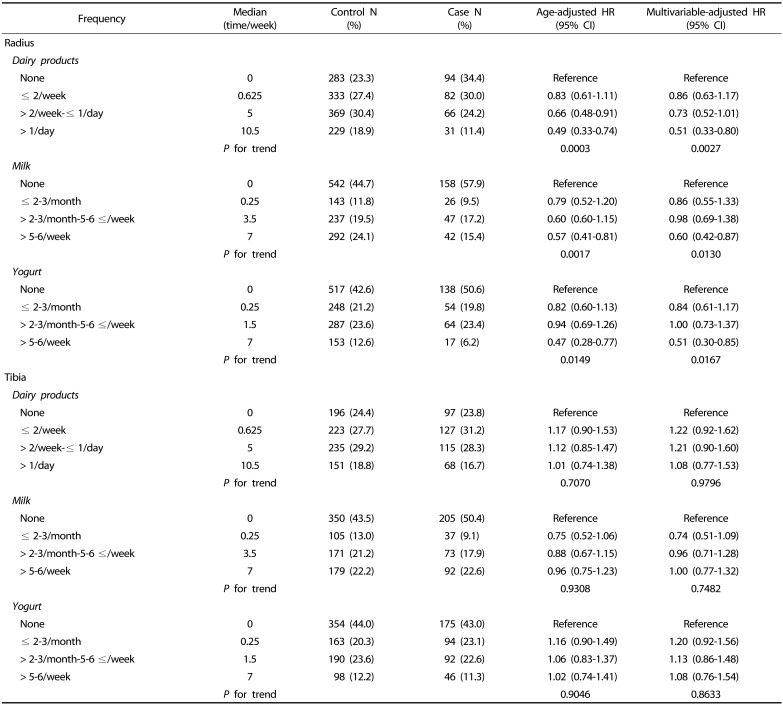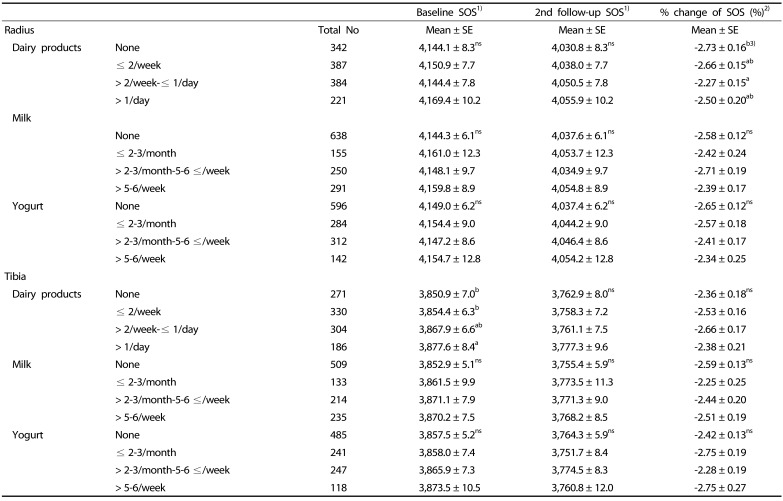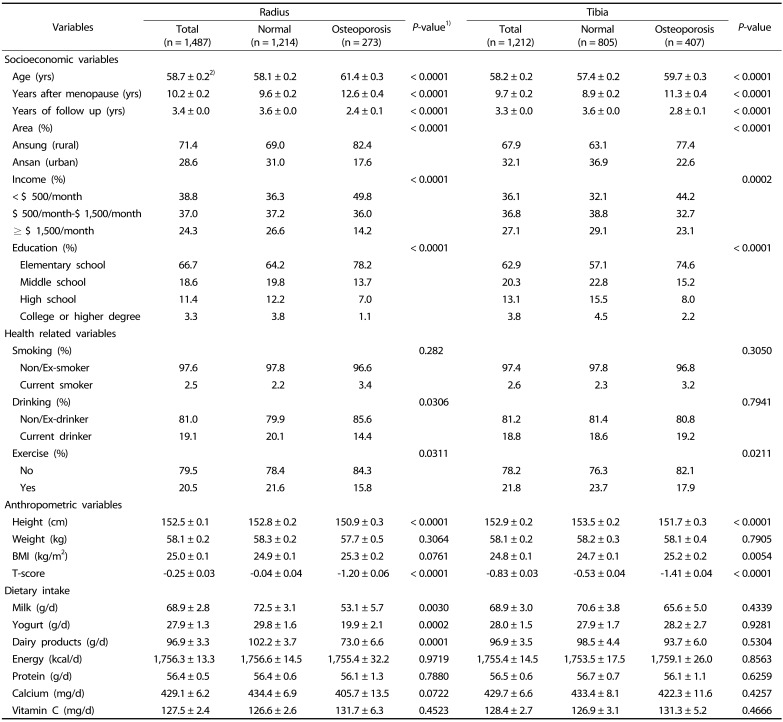1. Cummings SR, Melton LJ. Epidemiology and outcomes of osteoporotic fractures. Lancet. 2002; 359:1761–1767. PMID:
12049882.

2. Coughlan T, Dockery F. Osteoporosis and fracture risk in older people. Clin Med (Lond). 2014; 14:187–191. PMID:
24715132.

3. Rizzoli R. Dairy products, yogurts, and bone health. Am J Clin Nutr. 2014; 99:1256S–1262S. PMID:
24695889.

4. Cumming RG, Nevitt MC. Calcium for prevention of osteoporotic fractures in postmenopausal women. J Bone Miner Res. 1997; 12:1321–1329. PMID:
9286747.

5. Kanis JA, Johansson H, Oden A, De Laet C, Johnell O, Eisman JA, Mc Closkey E, Mellstrom D, Pols H, Reeve J, Silman A, Tenenhouse A. A meta-analysis of milk intake and fracture risk: low utility for case finding. Osteoporos Int. 2005; 16:799–804. PMID:
15502959.

6. Michaëlsson K, Wolk A, Langenskiöld S, Basu S, Warensjö Lemming E, Melhus H, Byberg L. Milk intake and risk of mortality and fractures in women and men: cohort studies. BMJ. 2014; 349:g6015. PMID:
25352269.

7. Włodarek D, Głąbska D, Kołota A, Adamczyk P, Czekajło A, Grzeszczak W, Drozdzowska B, Pluskiewicz W. Calcium intake and osteoporosis: the influence of calcium intake from dairy products on hip bone mineral density and fracture incidence - a populationbased study in women over 55 years of age. Public Health Nutr. 2014; 17:383–389. PMID:
23217270.

8. Durosier-Izart C, Biver E, Merminod F, van Rietbergen B, Chevalley T, Herrmann FR, Ferrari SL, Rizzoli R. Peripheral skeleton bone strength is positively correlated with total and dairy protein intakes in healthy postmenopausal women. Am J Clin Nutr. 2017; 105:513–525. PMID:
28077378.

9. Korea Health Industry Development Institute (KHIDI). National Food & Nutrition Statistics 2013: based on 2013 Korea National Health and Nutrition Examination Survey [Internet]. Cheongju: Korea Health Industry Development Institute;2015. cited 2018 January 10. Available from:
https://www.khidi.or.kr/.
10. Ministry of Health and Welfare, Korea Centers for Disease Control and Prevention. Korea Health Statistics 2010: Korean National Health & Nutrition Examination Survey. Seoul: Korea Centers for Disease Control and Prevention;2010.
11. Wright NC, Looker AC, Saag KG, Curtis JR, Delzell ES, Randall S, Dawson-Hughes B. The recent prevalence of osteoporosis and low bone mass in the United States based on bone mineral density at the femoral neck or lumbar spine. J Bone Miner Res. 2014; 29:2520–2526. PMID:
24771492.

12. Lim YS, Lee SW, Tserendejid Z, Jeong SY, Go G, Park HR. Prevalence of osteoporosis according to nutrient and food group intake levels in Korean postmenopausal women: using the 2010 Korea National Health and Nutrition Examination Survey Data. Nutr Res Pract. 2015; 9:539–546. PMID:
26425285.

13. Shin A, Lim S, Sung J, Myung S, Kim J. Dietary habit and bone mineral density in Korean postmenopausal women. Osteoporos Int. 2010; 21:947–955. PMID:
19727908.

14. Hong H, Kim EK, Lee JS. Effects of calcium intake, milk and dairy product intake, and blood vitamin D level on osteoporosis risk in Korean adults: analysis of the 2008 and 2009 Korea National Health and Nutrition Examination Survey. Nutr Res Pract. 2013; 7:409–417. PMID:
24133621.

15. Baek SW, Lee HO, Kim HJ, Won ES, Ha YS, Shin YK, Om AS. Relationship between intake of milk and milk products and bone health by sex and age-group in Koreans using data from the Korea National Health and Nutrition Examination Survey 2008~2011. J Korean Soc Food Sci Nutr. 2017; 46:513–522.
16. Seo HB, Choi YS. Sex- and age group-specific associations between intakes of dairy foods and pulses and bone health in Koreans aged 50 years and older: based on 2008~2011 Korea National Health and Nutrition Examination Survey. J Nutr Health. 2016; 49:165–178.

17. Kim Y, Han BG. KoGES group. Cohort profile: The Korean Genome and Epidemiology Study (KoGES) consortium. Int J Epidemiol. 2017; 46:e20. PMID:
27085081.

18. McCrory MA, McCrory MA, Hajduk CL, Roberts SB. Procedures for screening out inaccurate reports of dietary energy intake. Public Health Nutr. 2002; 5:873–882. PMID:
12633510.

19. Ahn Y, Lee JE, Cho NH, Shin C, Park C, Oh BS, Kimm K. Validation and calibration of semi-quantitative food frequency questionnaire: with participants of the Korean Health and Genome Study. Korean J Community Nutr. 2004; 9:173–182.
20. Ahn Y, Kwon E, Shim JE, Park MK, Joo Y, Kimm K, Park C, Kim DH. Validation and reproducibility of food frequency questionnaire for Korean genome epidemiologic study. Eur J Clin Nutr. 2007; 61:1435–1441. PMID:
17299477.

21. The Korean Nutrition Society. Recommended Dietary Allowances for Koreans. 7th revision. Seoul: The Korean Nutrition Society;2000.
22. Damilakis J, Papadokostakis G, Vrahoriti H, Tsagaraki I, Perisinakis K, Hadjipavlou A, Gourtsoyiannis N. Ultrasound velocity through the cortex of phalanges, radius, and tibia in normal and osteoporotic postmenopausal women using a new multisite quantitative ultrasound device. Invest Radiol. 2003; 38:207–211. PMID:
12649644.

23. Chong KH, Poh BK, Jamil NA, Kamaruddin NA, Deurenberg P. Radial quantitative ultrasound and dual energy x-ray absorptiometry: intermethod agreement for bone status assessment in children. Biomed Res Int. 2015; 2015:232876. PMID:
25922831.

24. Pisani P, Renna MD, Conversano F, Casciaro E, Muratore M, Quarta E, Paola MD, Casciaro S. Screening and early diagnosis of osteoporosis through x-ray and ultrasound based techniques. World J Radiol. 2013; 5:398–410. PMID:
24349644.
25. Hans D, Genton L, Allaoua S, Pichard C, Slosman DO. Hip fracture discrimination study: QUS of the radius and the calcaneum. J Clin Densitom. 2003; 6:163–172. PMID:
12794239.
26. Assessment of fracture risk and its application to screening for postmenopausal osteoporosis. Report of a WHO Study Group. World Health Organ Tech Rep Ser. 1994; 843:1–129. PMID:
7941614.
27. Cashman KD. Diet, nutrition, and bone health. J Nutr. 2007; 137:2507S–2512S. PMID:
17951494.

28. Weaver CM. The role of nutrition on optimizing peak bone mass. Asia Pac J Clin Nutr. 2008; 17(Suppl 1):135–137. PMID:
18296321.
29. Renner E. Dairy calcium, bone metabolism, and prevention of osteoporosis. J Dairy Sci. 1994; 77:3498–3505. PMID:
7699131.

30. Caroli A, Poli A, Ricotta D, Banfi G, Cocchi D. Invited review: dairy intake and bone health: a viewpoint from the state of the art. J Dairy Sci. 2011; 94:5249–5262. PMID:
22032348.

31. Uusi-Rasi K, Sievänen H, Pasanen M, Oja P, Vuori I. Associations of calcium intake and physical activity with bone density and size in premenopausal and postmenopausal women: a peripheral quantitative computed tomography study. J Bone Miner Res. 2002; 17:544–552. PMID:
11874246.

32. Uusi-Rasi K, Sievänen H, Vuori I, Pasanen M, Heinonen A, Oja P. Associations of physical activity and calcium intake with bone mass and size in healthy women at different ages. J Bone Miner Res. 1998; 13:133–142. PMID:
9443799.

33. Sahni S, Mangano KM, Tucker KL, Kiel DP, Casey VA, Hannan MT. Protective association of milk intake on the risk of hip fracture: results from the Framingham Original Cohort. J Bone Miner Res. 2014; 29:1756–1762. PMID:
24760749.

34. Kung AW, Lee KK, Ho AY, Tang G, Luk KD. Ten-year risk of osteoporotic fractures in postmenopausal Chinese women according to clinical risk factors and BMD T-scores: a prospective study. J Bone Miner Res. 2007; 22:1080–1087. PMID:
17371165.

35. Chen T, Chen PJ, Fung CS, Lin CJ, Yao WJ. Quantitative assessment of osteoporosis from the tibia shaft by ultrasound techniques. Med Eng Phys. 2004; 26:141–145. PMID:
15036181.

36. Hung VW, Qin L, Au SK, Choy WY, Leung KS, Leung PC, Cheng JC. Correlations of calcaneal QUS with pQCT measurements at distal tibia and non-weight-bearing distal radius. J Bone Miner Metab. 2004; 22:486–490. PMID:
15316870.







 PDF
PDF ePub
ePub Citation
Citation Print
Print




 XML Download
XML Download